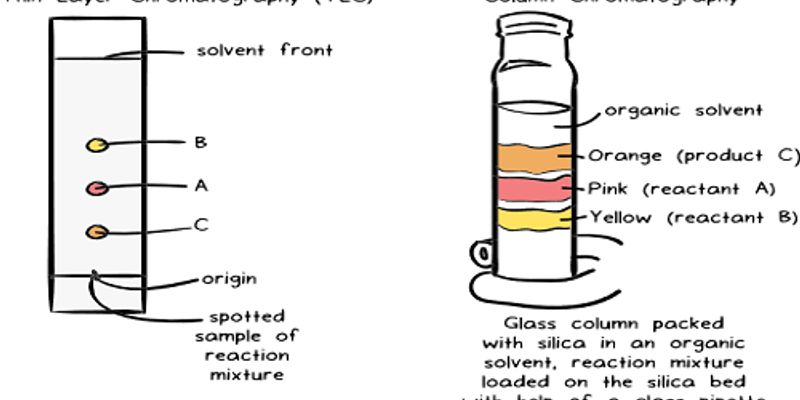Chromatography
Chromatography: an analytical technique commonly used for separating a mixture of chemical substances into its individual components, so that the individual components can be thoroughly analyzed. . The mixture is dissolved in a fluid called the mobile phase, which carries it through a structure holding another material called the stationary phase. The various constituents of the mixture travel at different speeds, causing them to separate. The separation is based on differential partitioning between the mobile and stationary phases. Subtle differences in a compound's partition coefficient result in differential retention on the stationary phase and thus affect the separation.
-
NOV 14, 2018 | 7:30 AMAs the diagnostic test menu has increased in size and complexity, healthcare providers are in great need of advice on appropriate test selection and result interpretation. To address this nee...Speaker: Michael Laposata, MD, PhDOCT 25, 2018 | 12:00 PMAnalytical chemistry can take you to strange places - for me it has been to the bottom of a quarry, being covered in dirt, excavating sesame-seed sized fossils that allow us to work out when...OCT 25, 2018 | 10:30 AMEveryone that uses titration in their lab knows how simple and fast the technique can be. However, uncertainty around when to replace electrodes creates confusion. Reagent quality, tubi...Speaker: Jessica McVay , Lori SpaffordOCT 25, 2018 | 9:00 AMHydrogen-deuterium exchange mass spectrometry (HDX-MS) has developed into a powerful tool for investigating biopharmaceuticals, protein interactions, and membrane protein dynamics. Since 2010...OCT 25, 2018 | 7:30 AMAlzheimer’s disease is becoming a public health crisis as the anticipated number of sufferers is expected to rise to 15 million in the next 30 years, at least in the US. These numbers a...OCT 24, 2018 | 1:30 PMThis intensive workshop will introduce infrared spectroscopy, outline the various sample handling methods and provide guidance on the numerous transmission and reflectance methods available f...OCT 24, 2018 | 12:00 PMIon mobility-mass spectrometry (IM-MS) is a rapid, gas-phase separation technique that has become an integral part of the analytical repertoire of techniques for the -omics. This method coupl...OCT 24, 2018 | 10:30 AMTwo-dimensional (2D) 1H-13C methyl correlated NMR is increasingly being recognized as a powerful tool to characterize the higher order structure (HOS) of monoclonal antibody (mAb) therapeutic...OCT 24, 2018 | 9:00 AMSolid phase microextraction (SPME) is a versatile, non-exhaustive sample preparation tool that has been demonstrated to be well-suited for facile and effective analysis of a broad range of co...Speaker: Barbara Bojko, PhD , Janusz Pawliszyn, PhD, FCIC, FRSCPresented at: Analytical Chemistry Virtual Event Series 2018
OCT 24, 2018 | 7:30 AMIn the postgenomic era, one expects the suite of chemical players in a brain region to be known and their functions uncovered. Perhaps surprisingly, many neurochemicals remain poorly characte...OCT 24, 2018 | 6:00 AMA fast, reliable and low cost characterization of materials/ products as fed to a process, and/or resulting from different processing actions, represents one of the most challenging targets i...OCT 11, 2018 | 1:30 PMRecent work has identified epigenomic features of distal regulatory elements to be dynamic and defining indicators of cellular specification and transformation. Of particular relevance is our...Speaker: Martin Hirst, PhDOCT 11, 2018 | 1:30 PMAs the most common female malignancy, breast cancer is the most likely reason that a woman will die of cancer around the world. Breast cancer mortality has dropped in the U.S. by 35% since 19...Speaker: Benjamin Anderson, MDOCT 11, 2018 | 12:00 PMAlthough targeted therapies often elicit profound initial patient responses, these effects are transient due to residual disease leading to acquired resistance. How tumors transition between...OCT 11, 2018 | 12:00 PMLung cancer is the leading cause of cancer-related mortality worldwide. Large-scale sequencing studies have revealed the complex genomic landscape of NSCLC and genomic differences between lun...Speaker: Nicholas McGranahan, PhDOCT 11, 2018 | 10:30 AMTwo projects looking at novel approaches to targeting inflammatory breast cancer will be presented. Inflammatory breast cancer (IBC) is a unique, understudied, and most lethal subtype account...Speaker: Kevin Williams, PhDOCT 11, 2018 | 10:30 AMAntibodies are extremely valuable and ubiquitous tools in life science research, but in spite of their widespread use in immunoassays over the past several decades, there is still a lack of u...Speaker: Chandra Mohan, PhDOCT 11, 2018 | 9:00 AMThe oncogenic transcription factor c-MYC (MYC) is deregulated, and often overexpressed, in more than 50% of cancers. MYC deregulation is associated with poor prognosis and aggressive disease,...Speaker: Jason De Melo, PhDOCT 11, 2018 | 9:00 AMIn the last two decades, large amount of next-generation sequencing (NGS) and -omics data has been generated in the field of immuno-oncology. Generating hypotheses by analyzing hundreds if no...Speaker: Devendra Mistry, PhDOCT 11, 2018 | 7:30 AMIn the past two decades a small number of infrequently dividing cells have been proposed as the source of multi-drug resistance during cancer treatment. These cells identified by their expres...Speaker: Krastan Blagoev, PhDOCT 11, 2018 | 6:00 AMPacBio Sequencing simultaneously provides long sequence reads, high consensus accuracy, minimal sequence bias, and methylation detection. I will highlight new advances and updates on applying...Speaker: Jonas Korlach, PhDOCT 10, 2018 | 12:00 PMTo date the anatomic extent of tumor (TNM-classification) has been by far the most important factors to predict the prognosis of cancer patients. However, this classification provides limited...Speaker: Jerome Galon, PhDOCT 10, 2018 | 12:00 PMRNA sequencing unlocks the mysteries hidden in the transcriptome. Whether your goal is gene expression analysis, gene fusion analysis, SNP analysis or miRNA expression analysis, achieving hig...Speaker: Jonathan Shaffer, PhD, MBAOCT 10, 2018 | 10:30 AMThe microbiome signatures in the context of gynecologic cancers (endometrial and ovarian) and the potential for their clinical use will be discussed. The use of microfluidic technologies to i...Speaker: Marina Walther-Antonio, PhD
NOV 14, 2018 | 7:30 AM
As the diagnostic test menu has increased in size and complexity, healthcare providers are in great need of advice on appropriate test selection and result interpretation. To address this nee...
Speaker:
Michael Laposata, MD, PhD
OCT 25, 2018 | 12:00 PM
Analytical chemistry can take you to strange places - for me it has been to the bottom of a quarry, being covered in dirt, excavating sesame-seed sized fossils that allow us to work out when...
OCT 25, 2018 | 10:30 AM
Everyone that uses titration in their lab knows how simple and fast the technique can be. However, uncertainty around when to replace electrodes creates confusion. Reagent quality, tubi...
Speaker:
Jessica McVay
, Lori Spafford
OCT 25, 2018 | 9:00 AM
Hydrogen-deuterium exchange mass spectrometry (HDX-MS) has developed into a powerful tool for investigating biopharmaceuticals, protein interactions, and membrane protein dynamics. Since 2010...
OCT 25, 2018 | 7:30 AM
Alzheimer’s disease is becoming a public health crisis as the anticipated number of sufferers is expected to rise to 15 million in the next 30 years, at least in the US. These numbers a...
OCT 24, 2018 | 1:30 PM
This intensive workshop will introduce infrared spectroscopy, outline the various sample handling methods and provide guidance on the numerous transmission and reflectance methods available f...
OCT 24, 2018 | 12:00 PM
Ion mobility-mass spectrometry (IM-MS) is a rapid, gas-phase separation technique that has become an integral part of the analytical repertoire of techniques for the -omics. This method coupl...
OCT 24, 2018 | 10:30 AM
Two-dimensional (2D) 1H-13C methyl correlated NMR is increasingly being recognized as a powerful tool to characterize the higher order structure (HOS) of monoclonal antibody (mAb) therapeutic...
OCT 24, 2018 | 9:00 AM
Solid phase microextraction (SPME) is a versatile, non-exhaustive sample preparation tool that has been demonstrated to be well-suited for facile and effective analysis of a broad range of co...
Speaker:
Barbara Bojko, PhD
, Janusz Pawliszyn, PhD, FCIC, FRSC
Presented at: Analytical Chemistry Virtual Event Series 2018
OCT 24, 2018 | 7:30 AM
In the postgenomic era, one expects the suite of chemical players in a brain region to be known and their functions uncovered. Perhaps surprisingly, many neurochemicals remain poorly characte...
OCT 24, 2018 | 6:00 AM
A fast, reliable and low cost characterization of materials/ products as fed to a process, and/or resulting from different processing actions, represents one of the most challenging targets i...
OCT 11, 2018 | 1:30 PM
Recent work has identified epigenomic features of distal regulatory elements to be dynamic and defining indicators of cellular specification and transformation. Of particular relevance is our...
Speaker:
Martin Hirst, PhD
OCT 11, 2018 | 1:30 PM
As the most common female malignancy, breast cancer is the most likely reason that a woman will die of cancer around the world. Breast cancer mortality has dropped in the U.S. by 35% since 19...
Speaker:
Benjamin Anderson, MD
OCT 11, 2018 | 12:00 PM
Although targeted therapies often elicit profound initial patient responses, these effects are transient due to residual disease leading to acquired resistance. How tumors transition between...
OCT 11, 2018 | 12:00 PM
Lung cancer is the leading cause of cancer-related mortality worldwide. Large-scale sequencing studies have revealed the complex genomic landscape of NSCLC and genomic differences between lun...
Speaker:
Nicholas McGranahan, PhD
OCT 11, 2018 | 10:30 AM
Two projects looking at novel approaches to targeting inflammatory breast cancer will be presented. Inflammatory breast cancer (IBC) is a unique, understudied, and most lethal subtype account...
Speaker:
Kevin Williams, PhD
OCT 11, 2018 | 10:30 AM
Antibodies are extremely valuable and ubiquitous tools in life science research, but in spite of their widespread use in immunoassays over the past several decades, there is still a lack of u...
Speaker:
Chandra Mohan, PhD
OCT 11, 2018 | 9:00 AM
The oncogenic transcription factor c-MYC (MYC) is deregulated, and often overexpressed, in more than 50% of cancers. MYC deregulation is associated with poor prognosis and aggressive disease,...
Speaker:
Jason De Melo, PhD
OCT 11, 2018 | 9:00 AM
In the last two decades, large amount of next-generation sequencing (NGS) and -omics data has been generated in the field of immuno-oncology. Generating hypotheses by analyzing hundreds if no...
Speaker:
Devendra Mistry, PhD
OCT 11, 2018 | 7:30 AM
In the past two decades a small number of infrequently dividing cells have been proposed as the source of multi-drug resistance during cancer treatment. These cells identified by their expres...
Speaker:
Krastan Blagoev, PhD
OCT 11, 2018 | 6:00 AM
PacBio Sequencing simultaneously provides long sequence reads, high consensus accuracy, minimal sequence bias, and methylation detection. I will highlight new advances and updates on applying...
Speaker:
Jonas Korlach, PhD
OCT 10, 2018 | 12:00 PM
To date the anatomic extent of tumor (TNM-classification) has been by far the most important factors to predict the prognosis of cancer patients. However, this classification provides limited...
Speaker:
Jerome Galon, PhD
OCT 10, 2018 | 12:00 PM
RNA sequencing unlocks the mysteries hidden in the transcriptome. Whether your goal is gene expression analysis, gene fusion analysis, SNP analysis or miRNA expression analysis, achieving hig...
Speaker:
Jonathan Shaffer, PhD, MBA
OCT 10, 2018 | 10:30 AM
The microbiome signatures in the context of gynecologic cancers (endometrial and ovarian) and the potential for their clinical use will be discussed. The use of microfluidic technologies to i...
Speaker:
Marina Walther-Antonio, PhD
























